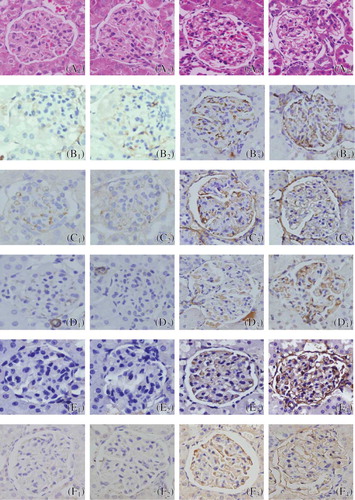Figures & data
Table 1. Parameters in two groups (mean ± SD)
Figure 1. Glomerular morphology was normal in sham group (A1: 9 weeks; A2: 13 weeks; HE). Proliferation occurring in the majority of glomerular mesangial cells and extracellular matrix in GS group, and degeneration of glomerular epithelial cells and infiltration of widespread mononuclear cells were shown (A3: 9 weeks; A4: 13 weeks; HE), especially in 13 weeks of GS group (A4). Representative samples of immunohistochemical staining for glomerular Col-IV (SHO: B1: 9 weeks, B2: 13 weeks; GS: B3: 9 weeks and B4: 13 weeks), FN (SHO: C1: 9 weeks, C2: 13 weeks; GS: C3: 9 weeks and C4: 13 weeks), α-SMA (SHO: D1: 9 weeks, D2: 13 weeks; GS: D3: 9 weeks and D4: 13 weeks), TGF-β1 (SHO: E1: 9 weeks, E2: 13 weeks; GS: E3: 9 weeks and E4: 13 weeks), and apoE (SHO: F1: 9 weeks, F2: 13 weeks; GS: F3: 9 weeks and F4: 13 weeks) were observed in all groups. Sham group (B1, B2, C1, C2, D1, D2, E1, E2, F1, and F2): positive staining (in brown) was faint in glomerulus, glomerular endothelial cells, glomerular basement membrane, mesangial cells, and visceral epithelial cells. GS group (B3, B4, C3, C4, D3, D4, E3, E4, F3, and F4): positive staining was strong in most glomerulus, glomerular endothelial cells, glomerular basement membrane, mesangial cells, and visceral epithelial cells, especially in those of 13 weeks (B4, C4, D4, E4, and F4). Magnification 400×.
Notes: SHO, sham operation group; GS, glomerulosclerosis model group; HE, hematoxylin and eosin; FN, fibronectin; α-SMA, α-smooth muscle actin; TGF-β1, transforming growth factor-β1; apoE, apolipoprotein E.

Table 2. Protein expression of apoE in glomerulus and mRNA expression of apoE in renal tissue of the two groups (mean ± SD)